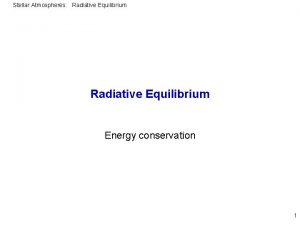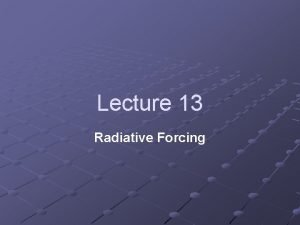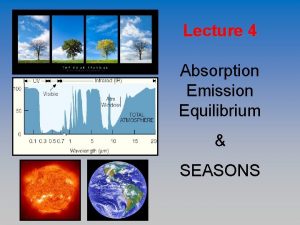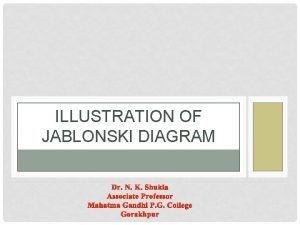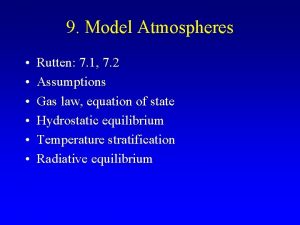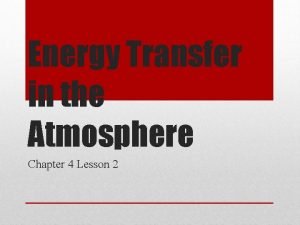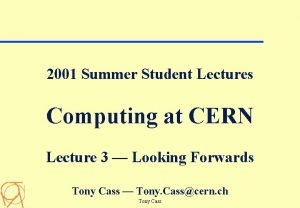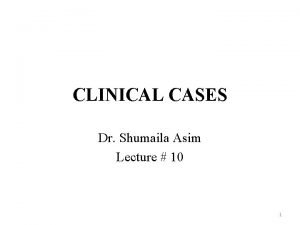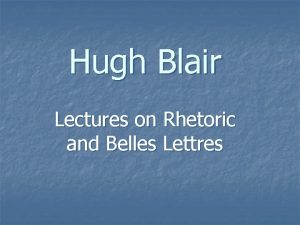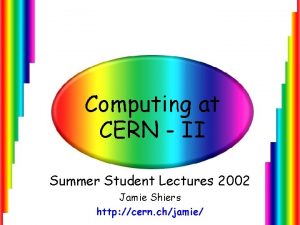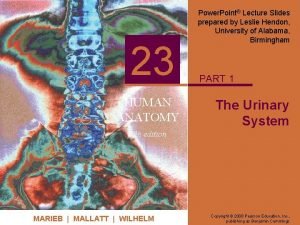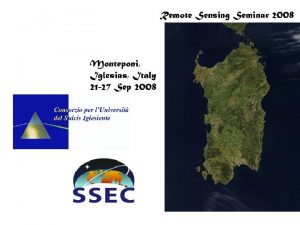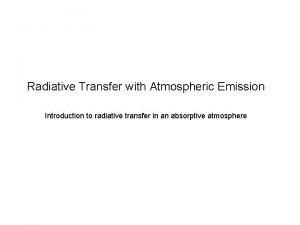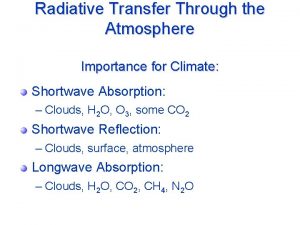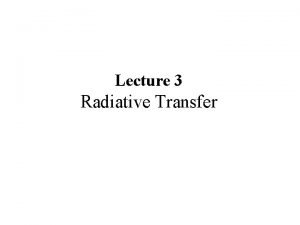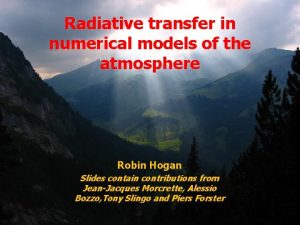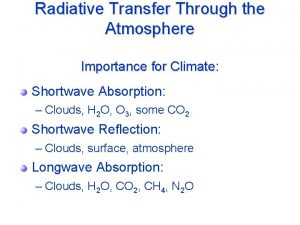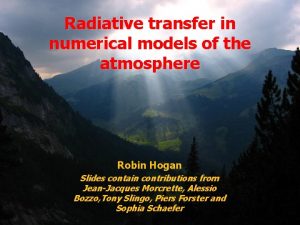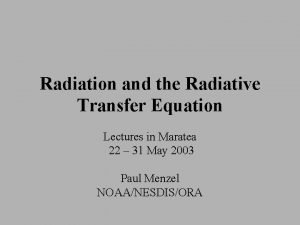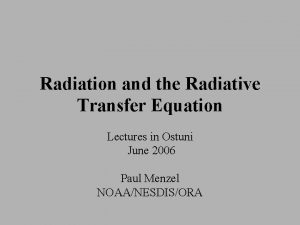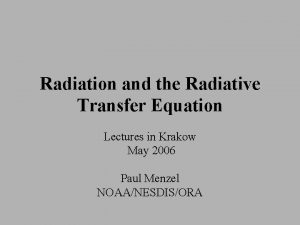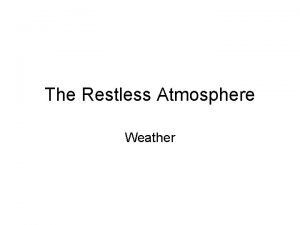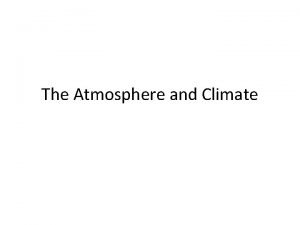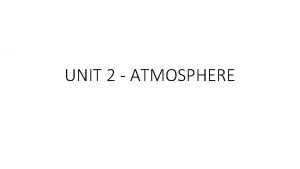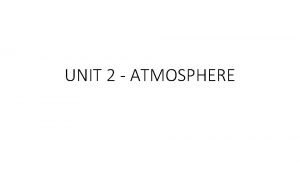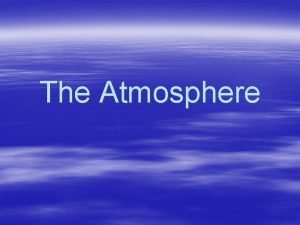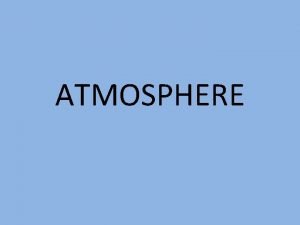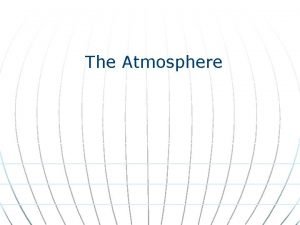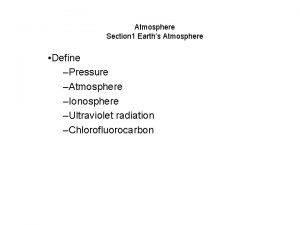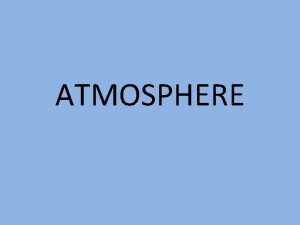Radiative Transfer in the Atmosphere Lectures in Monteponi
















































































- Slides: 80

Radiative Transfer in the Atmosphere Lectures in Monteponi September 2008 Paul Menzel UW/CIMSS/AOS

Outline Radiation Definitions Planck Function Emission, Absorption, Scattering Radiative Transfer Equation Satellite Derived Met Parameters Microwave Considerations

Satellite remote sensing of the Earth-atmosphere Observations depend on telescope characteristics (resolving power, diffraction) detector characteristics (signal to noise) communications bandwidth (bit depth) spectral intervals (window, absorption band) time of day (daylight visible) atmospheric state (T, Q, clouds) earth surface (Ts, vegetation cover)

Spectral Characteristics of Energy Sources and Sensing Systems

Terminology of radiant energy Energy from the Earth Atmosphere over time is Flux which strikes the detector area Irradiance at a given wavelength interval Monochromatic Irradiance over a solid angle on the Earth Radiance observed by satellite radiometer is described by The Planck function can be inverted to Brightness temperature

Definitions of Radiation _________________________________ QUANTITY SYMBOL UNITS _________________________________ Energy d. Q Joules Flux d. Q/dt Joules/sec = Watts Irradiance d. Q/dt/d. A Watts/meter 2 Monochromatic Irradiance d. Q/dt/d. A/d W/m 2/micron Radiance or d. Q/dt/d. A/d W/m 2/cm-1 d. Q/dt/d. A/d /d W/m 2/micron/ster or d. Q/dt/d. A/d /d W/m 2/cm-1/ster _________________________________

Using wavelengths Planck’s Law where Wien's Law c 2/λT B(λ, T) = c 1 / λ 5 / [e -1] (m. W/m 2/ster/cm) λ = wavelengths in cm T = temperature of emitting surface (deg K) c 1 = 1. 191044 x 10 -5 (m. W/m 2/ster/cm-4) c 2 = 1. 438769 (cm deg K) d. B(λmax, T) / dλ = 0 where λ(max) =. 2897/T indicates peak of Planck function curve shifts to shorter wavelengths (greater wavenumbers) with temperature increase. Note B(λmax, T) ~ T 5. Stefan-Boltzmann Law E = B(λ, T) dλ = T 4, where = 5. 67 x 10 -8 W/m 2/deg 4. o states that irradiance of a black body (area under Planck curve) is proportional to T 4. Brightness Temperature c 1 T = c 2 / [λ ln( _____ + 1)] is determined by inverting Planck function λ 5 Bλ

Spectral Distribution of Energy Radiated from Blackbodies at Various Temperatures

Bλ/Bλmax


BT 4 – BT 11

Observed BT at 4 micron Window Channel: • little atmospheric absorption • surface features clearly visible Range BT[250, 335] Range R[0. 2, 1. 7] Clouds are cold Values over land Larger than over water Reflected Solar everywhere Stronger over Sunglint

Observed BT at 11 micron Window Channel: • little atmospheric absorption • surface features clearly visible Range BT [220, 320] Range R [2. 1, 12. 4] Clouds are cold Values over land Larger than over water Undetectable Reflected Solar Even over Sunglint

Temperature Sensitivity of B(λ, T) for typical earth temperatures B (λ, T) / B (λ, 273 K) 4μm 6. 7μm 2 10μm 15μm microwave 1 200 201 250 300 Temperature (K)

Cloud edges and broken clouds appear different in 11 and 4 um images. T(11)**4=(1 -N)*Tclr**4+N*Tcld**4~(1 -N)*300**4+N*200**4 T(4)**12=(1 -N)*Tclr**12+N*Tcld**12~(1 -N)*300**12+N*200**12 Cold part of pixel has more influence for B(11) than B(4)


T SW and LW BTs for different cloud amounts when Tcld=220 and Tsfc=300 BT 4 280 260 BT 11 240 220 1. 0 0. 8 0. 6 0. 4 0. 2 0. 0 N

Using wavenumbers Planck’s Law where Wien's Law c 2 /T B( , T) = c 1 3 / [e -1] (m. W/m 2/ster/cm-1) = # wavelengths in one centimeter (cm-1) T = temperature of emitting surface (deg K) c 1 = 1. 191044 x 10 -5 (m. W/m 2/ster/cm-4) c 2 = 1. 438769 (cm deg K) d. B( max, T) / d = 0 where max) = 1. 95 T indicates peak of Planck function curve shifts to shorter wavelengths (greater wavenumbers) with temperature increase. Stefan-Boltzmann Law E = B( , T) d = T 4, where = 5. 67 x 10 -8 W/m 2/deg 4. o states that irradiance of a black body (area under Planck curve) is proportional to T 4. Brightness Temperature c 1 3 T = c 2 /[ln(______ + 1)] is determined by inverting Planck function B

Using wavenumbers Using wavelengths c 2 /T B( , T) = c 1 3 / [e -1] (m. W/m 2/ster/cm-1) (max in cm-1) = 1. 95 T (max in cm)T = 0. 2897 B( max, T) ~ T**3. B( max, T) ~ T**5. E = B( , T) d = T 4, o c 1 T = c 2/[ ln(______ + 1)] 5 B E = B( , T) d = T 4, o c 1 3 T = c 2 /[ln(______ + 1)] B c 2 / T B( , T) = c 1 /{ 5 [e -1] } (m. W/m 2/ster/ m)


Solar (visible) and Earth emitted (infrared) energy Incoming solar radiation (mostly visible) drives the earth-atmosphere (which emits infrared). Over the annual cycle, the incoming solar energy that makes it to the earth surface (about 50 %) is balanced by the outgoing thermal infrared energy emitted through the atmosphere. The atmosphere transmits, absorbs (by H 2 O, O 2, O 3, dust) reflects (by clouds), and scatters (by aerosols) incoming visible; the earth surface absorbs and reflects the transmitted visible. Atmospheric H 2 O, CO 2, and O 3 selectively transmit or absorb the outgoing infrared radiation. The outgoing microwave is primarily affected by H 2 O and O 2.

Relevant Material in Applications of Meteorological Satellites CHAPTER 2 - NATURE OF RADIATION 2. 1 Remote Sensing of Radiation 2. 2 Basic Units 2. 3 Definitions of Radiation 2. 5 Related Derivations 2 -1 2 -2 2 -5 CHAPTER 3 - ABSORPTION, EMISSION, REFLECTION, AND SCATTERING 3. 1 Absorption and Emission 3. 2 Conservation of Energy 3. 3 Planetary Albedo 3. 4 Selective Absorption and Emission 3. 7 Summary of Interactions between Radiation and Matter 3. 8 Beer's Law and Schwarzchild's Equation 3. 9 Atmospheric Scattering 3. 10 The Solar Spectrum 3. 11 Composition of the Earth's Atmosphere 3. 12 Atmospheric Absorption and Emission of Solar Radiation 3. 13 Atmospheric Absorption and Emission of Thermal Radiation 3. 14 Atmospheric Absorption Bands in the IR Spectrum 3. 15 Atmospheric Absorption Bands in the Microwave Spectrum 3. 16 Remote Sensing Regions 3 -1 3 -2 3 -6 3 -7 3 -9 3 -11 3 -12 3 -13 3 -14 CHAPTER 5 - THE RADIATIVE TRANSFER EQUATION (RTE) 5. 1 Derivation of RTE 5. 10 Microwave Form of RTE 5 -1 5 -28

Emission, Absorption, Reflection, and Scattering Blackbody radiation B represents the upper limit to the amount of radiation that a real substance may emit at a given temperature for a given wavelength. Emissivity is defined as the fraction of emitted radiation R to Blackbody radiation, = R /B . In a medium at thermal equilibrium, what is absorbed is emitted (what goes in comes out) so a = . Thus, materials which are strong absorbers at a given wavelength are also strong emitters at that wavelength; similarly weak absorbers are weak emitters. If a , r , and represent the fractional absorption, reflectance, and transmittance, respectively, then conservation of energy says a + r + = 1 . For a blackbody a = 1, it follows that r = 0 and = 0 for blackbody radiation. Also, for a perfect window = 1, a = 0 and r = 0. For any opaque surface = 0, so radiation is either absorbed or reflected a + r = 1. At any wavelength, strong reflectors are weak absorbers (i. e. , snow at visible wavelengths), and weak reflectors are strong absorbers (i. e. , asphalt at visible wavelengths).


Planetary Albedo Planetary albedo is defined as the fraction of the total incident solar irradiance, S, that is reflected back into space. Radiation balance then requires that the absorbed solar irradiance is given by E = (1 - A) S/4. The factor of one-fourth arises because the cross sectional area of the earth disc to solar radiation, r 2, is one-fourth the earth radiating surface, 4 r 2. Thus recalling that S = 1380 Wm-2, if the earth albedo is 30 percent, then E = 241 Wm-2.

Selective Absorption and Transmission Assume that the earth behaves like a blackbody and that the atmosphere has an absorptivity a. S for incoming solar radiation and a. L for outgoing longwave radiation. Let Ya be the irradiance emitted by the atmosphere (both upward and downward); Ys the irradiance emitted from the earth's surface; and E the solar irradiance absorbed by the earth-atmosphere system. Then, radiative equilibrium requires E - (1 -a. L) Ys - Ya = 0 , at the top of the atmosphere, (1 -a. S) E - Ys + Ya = 0 , at the surface. Solving yields (2 -a. S) Ys = E , and (2 -a. L) - (1 -a. L)(2 -a. S) Ya = E. (2 -a. L) Since a. L > a. S, the irradiance and hence the radiative equilibrium temperature at the earth surface is increased by the presence of the atmosphere. With a. L =. 8 and a. S =. 1 and E = 241 Wm-2, Stefans Law yields a blackbody temperature at the surface of 286 K, in contrast to the 255 K it would be if the atmospheric absorptance was independent of wavelength (a. S = a. L). The atmospheric gray body temperature in this example turns out to be 245 K.

Incoming Outgoing IR solar E (1 -al) Ys Ya top of the atmosphere (1 -as) E Ys Ya earth surface. (2 -a. S) Ys = E = Ts 4 (2 -a. L)

Expanding on the previous example, let the atmosphere be represented by two layers and let us compute the vertical profile of radiative equilibrium temperature. For simplicity in our two layer atmosphere, let a. S = 0 and a. L = a =. 5, u indicate upper layer, l indicate lower layer, and s denote the earth surface. Schematically we have: E (1 -a)2 Ys (1 -a)Yl Yu top of the atmosphere E (1 -a)Ys Yl Yu middle of the atmosphere E Ys Yl (1 -a)Yu earth surface. Radiative equilibrium at each surface requires E = . 25 Ys +. 5 Yl + Yu , E = . 5 Ys + Yl - Yu , E = Ys - Yl -. 5 Yu. Solving yields Ys = 1. 6 E, Yl =. 5 E and Yu =. 33 E. The radiative equilibrium temperatures (blackbody at the surface and gray body in the atmosphere) are readily computed. Ts = [1. 6 E / σ]1/4 = 287 K , Tl = [0. 5 E / 0. 5σ]1/4 = 255 K , Tu = [0. 33 E / 0. 5σ]1/4 = 231 K. Thus, a crude temperature profile emerges for this simple two-layer model of the atmosphere.

Transmittance Transmission through an absorbing medium for a given wavelength is governed by the number of intervening absorbing molecules (path length u) and their absorbing power (k ) at that wavelength. Beer’s law indicates that transmittance decays exponentially with increasing path length - k u (z) (z ) = e where the path length is given by u (z) = dz. z k u is a measure of the cumulative depletion that the beam of radiation has experienced as a result of its passage through the layer and is often called the optical depth . Realizing that the hydrostatic equation implies g dz = - q dp where q is the mixing ratio and is the density of the atmosphere, then p u (p) = q g-1 dp and o - k u (p) (p o ) = e .

Spectral Characteristics of Atmospheric Transmission and Sensing Systems

Relative Effects of Radiative Processes


Aerosol Size Distribution There are 3 modes : - « nucleation » : radius is between 0. 002 and 0. 05 m. They result from combustion processes, photo-chemical reactions, etc. - « accumulation » : radius is between 0. 05 m and 0. 5 m. Coagulation processes. - « coarse » : larger than 1 m. From mechanical processes like aeolian erosion. « fine » particles (nucleation and accumulation) result from anthropogenic activities, coarse particles come from natural processes. 0. 01 0. 1 1. 0 10. 0

Scattering of early morning sun light from haze

Measurements in the Solar Reflected Spectrum across the region covered by AVIRIS

AVIRIS Movie #1 AVIRIS Image - Linden CA 20 -Aug-1992 224 Spectral Bands: 0. 4 - 2. 5 mm Pixel: 20 m x 20 m Scene: 10 km x 10 km

AVIRIS Movie #2 AVIRIS Image - Porto Nacional, Brazil 20 -Aug-1995 224 Spectral Bands: 0. 4 - 2. 5 mm Pixel: 20 m x 20 m Scene: 10 km x 10 km

Relevant Material in Applications of Meteorological Satellites CHAPTER 2 - NATURE OF RADIATION 2. 1 Remote Sensing of Radiation 2. 2 Basic Units 2. 3 Definitions of Radiation 2. 5 Related Derivations 2 -1 2 -2 2 -5 CHAPTER 3 - ABSORPTION, EMISSION, REFLECTION, AND SCATTERING 3. 1 Absorption and Emission 3. 2 Conservation of Energy 3. 3 Planetary Albedo 3. 4 Selective Absorption and Emission 3. 7 Summary of Interactions between Radiation and Matter 3. 8 Beer's Law and Schwarzchild's Equation 3. 9 Atmospheric Scattering 3. 10 The Solar Spectrum 3. 11 Composition of the Earth's Atmosphere 3. 12 Atmospheric Absorption and Emission of Solar Radiation 3. 13 Atmospheric Absorption and Emission of Thermal Radiation 3. 14 Atmospheric Absorption Bands in the IR Spectrum 3. 15 Atmospheric Absorption Bands in the Microwave Spectrum 3. 16 Remote Sensing Regions 3 -1 3 -2 3 -6 3 -7 3 -9 3 -11 3 -12 3 -13 3 -14 CHAPTER 5 - THE RADIATIVE TRANSFER EQUATION (RTE) 5. 1 Derivation of RTE 5. 10 Microwave Form of RTE 5 -1 5 -28

Radiative Transfer Equation The radiance leaving the earth-atmosphere system sensed by a satellite borne radiometer is the sum of radiation emissions from the earth-surface and each atmospheric level that are transmitted to the top of the atmosphere. Considering the earth's surface to be a blackbody emitter (emissivity equal to unity), the upwelling radiance intensity, I , for a cloudless atmosphere is given by the expression I = sfc B ( Tsfc) (sfc - top) + layer B ( Tlayer) (layer - top) layers where the first term is the surface contribution and the second term is the atmospheric contribution to the radiance to space.

Re-emission of Infrared Radiation

Radiative Transfer through the Atmosphere

Rsfc R 1 R 2 top of the atmosphere τ2 = transmittance of upper layer of atm τ1= transmittance of lower layer of atm bb earth surface. Robs = Rsfc τ1 τ2 + R 1 (1 -τ1) τ2 + R 2 (1 - τ2)

In standard notation, I = sfc B (T(ps)) (ps) + ( p) B (T(p)) (p) p The emissivity of an infinitesimal layer of the atmosphere at pressure p is equal to the absorptance (one minus the transmittance of the layer). Consequently, ( p) (p) = [1 - ( p)] (p) Since transmittance is an exponential function of depth of absorbing constituent, p+ p p ( p) (p) = exp [ - k q g-1 dp] * exp [ - k q g-1 dp] = (p + p) p o Therefore ( p) (p) = (p) - (p + p) = - (p). So we can write I = sfc B (T(ps)) (ps) - B (T(p)) (p). p which when written in integral form reads ps I = sfc B (T(ps)) (ps) - B (T(p)) [ d (p) / dp ] dp. o

When reflection from the earth surface is also considered, the Radiative Transfer Equation for infrared radiation can be written where o I = sfc B (Ts) (ps) + B (T(p)) F (p) [d (p)/ dp] dp ps F (p) = { 1 + (1 - ) [ (ps) / (p)]2 } The first term is the spectral radiance emitted by the surface and attenuated by the atmosphere, often called the boundary term and the second term is the spectral radiance emitted to space by the atmosphere directly or by reflection from the earth surface. The atmospheric contribution is the weighted sum of the Planck radiance contribution from each layer, where the weighting function is [ d (p) / dp ]. This weighting function is an indication of where in the atmosphere the majority of the radiation for a given spectral band comes from.

Earth emitted spectra overlaid on Planck function envelopes O 3 CO 2 H 20 CO 2

Weighting Functions Longwave CO 2 14. 7 1 14. 4 2 14. 1 3 13. 9 4 13. 4 5 12. 7 6 12. 0 7 680 696 711 733 748 790 832 Midwave H 2 O & O 3 11. 0 8 907 9. 7 9 1030 7. 4 10 1345 7. 0 11 1425 6. 5 12 1535 CO 2, strat temp CO 2, upper trop temp CO 2, mid trop temp CO 2, lower trop temp H 2 O, lower trop moisture H 2 O, dirty window O 3, strat ozone H 2 O, lower mid trop moisture H 2 O, upper trop moisture

line broadening with pressure helps to explain weighting functions ABC High A Mid B ABC Low C

CO 2 channels see to different levels in the atmosphere 14. 2 um 13. 9 um 13. 6 um 13. 3 um

line broadening with pressure helps to explain weighting functions A b s o r p t i o n H e i g h t Wavenumber Energy Contribution

For a given water vapor spectral channel the weighting function depends on the amount of water vapor in the atmospheric column Wet Atm. H e i g h t Wet Moderate Dry Atm. Dry 0 Tau 100% =d. Tau/d. Ht CO 2 is about the same everywhere, the weighting function for a given CO 2 spectral channel is the same everywhere

Improvements with Hyperspectral IR Data


GOES-12 Sounder – Brightness Temperature (Radiances) – 12 bands

Characteristics of RTE * Radiance arises from deep and overlapping layers * The radiance observations are not independent * There is no unique relation between the spectrum of the outgoing radiance and T(p) or Q(p) * T(p) is buried in an exponent in the denominator in the integral * Q(p) is implicit in the transmittance * Boundary conditions are necessary for a solution; the better the first guess the better the final solution

To investigate the RTE further consider the atmospheric contribution to the radiance to space of an infinitesimal layer of the atmosphere at height z, d. Iλ(z) = Bλ(T(z)) d λ(z). Assume a well-mixed isothermal atmosphere where the density drops off exponentially with height ρ = ρo exp ( - z), and assume kλ is independent of height, so that the optical depth can be written for normal incidence σλ = kλ ρ dz = -1 kλ ρo exp( - z) z and the derivative with respect to height dσλ = - k ρ exp( - z) = - σ λ o λ . dz Therefore, we may obtain an expression for the detected radiance per unit thickness of the layer as a function of optical depth, d. Iλ(z) d λ(z) = Bλ(Tconst) σλ exp (-σλ) . dz dz The level which is emitting the most detected radiance is given by d d. Iλ(z) { } = 0 , or where σ = 1. λ dz Most of monochromatic radiance detected is emitted by layers near level of unit optical depth.

Profile Retrieval from Sounder Radiances ps I = sfc B (T(ps)) (ps) - B (T(p)) F (p) [ d (p) / dp ] dp. o I 1, I 2, I 3, . . , In are measured with the sounder P(sfc) and T(sfc) come from ground based conventional observations (p) are calculated with physics models (using for CO 2 and O 3) sfc is estimated from a priori information (or regression guess) First guess solution is inferred from (1) in situ radiosonde reports, (2) model prediction, or (3) blending of (1) and (2) Profile retrieval from perturbing guess to match measured sounder radiances

Example GOES Sounding

GOES Sounders –Total Precipitable Water

GOES Sounders –Lifted Index Stability



Sounder Retrieval Products ps I = (sfc) B (T(ps)) (ps) - B (T(p)) F (p) [ d (p) / dp ] dp. o Direct brightness temperatures Derived in Clear Sky 20 retrieved temperatures (at mandatory levels) 20 geo-potential heights (at mandatory levels) 11 dewpoint temperatures (at 300 h. Pa and below) 3 thermal gradient winds (at 700, 500, 400 h. Pa) 1 total precipitable water vapor 1 surface skin temperature 2 stability index (lifted index, CAPE) Derived in Cloudy conditions 3 cloud parameters (amount, cloud top pressure, and cloud top temperature) Mandatory Levels (in h. Pa) sfc 1000 950 920 850 780 700 670 500 400 300 250 200 150 100 70 50 30 20 10


BT differences resulting from 10 ppmv change in CO 2 concentration

Microwave RTE Lectures in Monteponi September 2008 Paul Menzel UW/CIMSS/AOS


Radiation is governed by Planck’s Law c 2 / T B( , T) = c 1 /{ 5 [e -1] } In microwave region c 2 /λT << 1 so that c 2 / T e = 1 + c 2 /λT + second order And classical Rayleigh Jeans radiation equation emerges Bλ(T) [c 1 / c 2 ] [T / λ 4] Radiance is linear function of brightness temperature.

Microwave Form of RTE atm ps 'λ(p) ref atm sfc Isfc = ελ Bλ(Ts) λ(ps) + (1 -ελ) λ(ps) Bλ(T(p)) d ln p λ o ln p ps 'λ(p) Iλ = ελ Bλ(Ts) λ(ps) + (1 -ελ) λ(ps) Bλ(T(p)) d ln p o ln p o λ(p) _____ + Bλ(T(p)) d ln p sfc ps ln p In the microwave region c 2 /λT << 1, so the Planck radiance is linearly proportional to the brightness temperature Bλ(T) [c 1 / c 2 ] [T / λ 4] So o λ(p) Tbλ = ελ Ts(ps) λ(ps) + T(p) Fλ(p) d ln p ps ln p where λ(ps) Fλ(p) = { 1 + (1 - ελ) [ ]2 }. λ(p)

The transmittance to the surface can be expressed in terms of transmittance to the top of the atmosphere by remembering 1 ps 'λ(p) = exp [ - kλ(p) g(p) dp ] g p ps p = exp [ - + ] o o So = λ(ps) / λ(p) . 'λ(p) λ(ps) λ(p) = - . ln p ( λ(p))2 ln p [ remember that λ(ps, p) λ(p, 0) = λ(ps, 0) and λ(ps, p) = λ(p, ps) ]


Spectral regions used for remote sensing of the earth atmosphere and surface from satellites. indicates emissivity, q denotes water vapour, and T represents temperature.


Microwave spectral bands 23. 8 GHz dirty window H 2 O absorption 31. 4 GHz window 60 GHz O 2 sounding 120 GHz O 2 sounding 183 GHz H 2 O sounding

23. 8, 31. 4, 50. 3, 52. 8, 53. 6, 54. 4, 54. 9, 55. 5, 57. 3 (6 chs), 89. 0 GHz

Microwave Spectral Features II II I |I I ATMS Spectral Regions

AMSU 23. 8 31. 4 50. 3 GHz

AMSU 23. 8 dirty window atm Q warms BT 31. 4 window 50. 3 GHz

Low mist over ocean m , m rs , s Tb = s Ts m + m Tm + m rs m Tm Tb = s Ts (1 - m) + m Tm + m (1 - s) (1 - m) Tm So temperature difference of low moist over ocean from clear sky over ocean is given by ΔTb = - s m Ts + m Tm + m (1 - s) (1 - m) Tm For s ~ 0. 5 and Ts ~ Tm this is always positive for 0 < m < 1

AMSU 52. 8 53. 6 54. 4 GHz

AMSU 54. 4 54. 9 55. 5 GHz
 Radiative equilibrium temperature
Radiative equilibrium temperature Radiative forcing definition
Radiative forcing definition Radiative equilibrium temperature
Radiative equilibrium temperature Jablonsky diagram
Jablonsky diagram Radiative equilibrium temperature
Radiative equilibrium temperature Lesson 2 energy transfer in the atmosphere
Lesson 2 energy transfer in the atmosphere Waves are repeating disturbances that transfer
Waves are repeating disturbances that transfer Radio astronomy lectures
Radio astronomy lectures Pathology lectures for medical students
Pathology lectures for medical students Reinforcement learning lectures
Reinforcement learning lectures Medical student hematology lectures
Medical student hematology lectures Molecular biology lectures
Molecular biology lectures C programming and numerical analysis an introduction
C programming and numerical analysis an introduction Rick trebino
Rick trebino Power system lectures
Power system lectures Do words have power
Do words have power Cern summer school lectures
Cern summer school lectures Comsats virtual campus lectures
Comsats virtual campus lectures Theory of translation lectures
Theory of translation lectures Uva powerpoint
Uva powerpoint Cs106b
Cs106b Guyton physiology lectures
Guyton physiology lectures Dr sohail lectures
Dr sohail lectures Dr asim lectures
Dr asim lectures Bba lectures
Bba lectures Stratog online lectures
Stratog online lectures Haematology lectures
Haematology lectures Theory and practice of translation lectures
Theory and practice of translation lectures Lectures paediatrics
Lectures paediatrics Computer networks kurose
Computer networks kurose Frcr physics lectures
Frcr physics lectures Hugh blair lectures on rhetoric
Hugh blair lectures on rhetoric Reinforcement learning lectures
Reinforcement learning lectures Cdeep lectures
Cdeep lectures Ludic space
Ludic space Define aerodynamics
Define aerodynamics Utilities and energy lectures
Utilities and energy lectures Ota core curriculum
Ota core curriculum Bhadeshia lectures
Bhadeshia lectures Bureau of lectures
Bureau of lectures Translation 1
Translation 1 Data mining lectures
Data mining lectures Hegel philosophy
Hegel philosophy Heel effect
Heel effect Cern summer student lectures
Cern summer student lectures 13 lectures
13 lectures Medical emergency student lectures
Medical emergency student lectures Activity based approach in software project management
Activity based approach in software project management Oral communication 3 lectures text
Oral communication 3 lectures text Theory of translation lectures
Theory of translation lectures Anatomy lectures powerpoint
Anatomy lectures powerpoint Introduction to web engineering
Introduction to web engineering Ota resident lectures
Ota resident lectures Trend lectures
Trend lectures Digital logic design lectures
Digital logic design lectures Advanced medicinal chemistry
Advanced medicinal chemistry Nuclear medicine lectures
Nuclear medicine lectures Introduction to recursion
Introduction to recursion ưu thế lai là gì
ưu thế lai là gì Thẻ vin
Thẻ vin Cái miệng nó xinh thế
Cái miệng nó xinh thế Thể thơ truyền thống
Thể thơ truyền thống Các châu lục và đại dương trên thế giới
Các châu lục và đại dương trên thế giới Bổ thể
Bổ thể Từ ngữ thể hiện lòng nhân hậu
Từ ngữ thể hiện lòng nhân hậu Diễn thế sinh thái là
Diễn thế sinh thái là Tư thế ngồi viết
Tư thế ngồi viết Thế nào là giọng cùng tên? *
Thế nào là giọng cùng tên? * Phép trừ bù
Phép trừ bù Hát lên người ơi
Hát lên người ơi Khi nào hổ mẹ dạy hổ con săn mồi
Khi nào hổ mẹ dạy hổ con săn mồi đại từ thay thế
đại từ thay thế Vẽ hình chiếu vuông góc của vật thể sau
Vẽ hình chiếu vuông góc của vật thể sau Cong thức tính động năng
Cong thức tính động năng Thế nào là mạng điện lắp đặt kiểu nổi
Thế nào là mạng điện lắp đặt kiểu nổi Hát kết hợp bộ gõ cơ thể
Hát kết hợp bộ gõ cơ thể Tỉ lệ cơ thể trẻ em
Tỉ lệ cơ thể trẻ em Lời thề hippocrates
Lời thề hippocrates Các loại đột biến cấu trúc nhiễm sắc thể
Các loại đột biến cấu trúc nhiễm sắc thể Vẽ hình chiếu đứng bằng cạnh của vật thể
Vẽ hình chiếu đứng bằng cạnh của vật thể Phản ứng thế ankan
Phản ứng thế ankan
